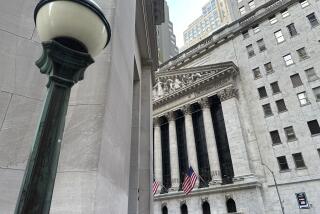Dow Dips 1.97; Stock Market Trims Early Losses
- Share via
NEW YORK — Stock prices finished slightly lower Friday and gave the Dow Jones industrial average its only consecutive loss of the month, but the broad market displayed resilience and analysts said Wall Street’s 1987 rally showed little sign of flagging.
“The easiest path is still up,” said Jack Solomon, a strategist at the New York investment firm Bear Stearns Cos. “They just cannot drive this market into the ground.”
After hitting an 18-point deficit during mid-session, the Dow Jones industrials rebounded on renewed buying interest and computer-driven program trading in the final half hour and ended at 2,158.04, down 1.97 points.
Coupled with the 3.38-point loss Thursday, it was the only time Wall Street’s most familiar indicator had a consecutive decline in January and was only the fourth time in the month it finished lower.
But that still left the average up 56.52 points for the week and 262.09 points higher for January, a gain of 13.8%.
Broader market barometers were mixed, reflecting resilient strength in secondary and over-the-counter stocks. The American Stock Exchange market-value index closed up 0.67 to 300.47, its fourth-straight record high.
Decline in Volume
Volume on the New York Stock Exchange totaled 163.36 million shares, compared to 205.25 million Thursday. Losing issues narrowly outnumbered gainers
“I think there was just the normal volume of profit taking today,” said Jack Garry, head of equity trading at the Philadelphia investment firm of Butcher & Singer Inc. “I’m sure program trading played a role.”
Program trading is a form of arbitrage used by large brokerages to profit from disparities between the prices of stocks and stock futures. It can trigger heavy volatility.
When stock prices rise above the futures prices, computer programs automatically sell massive amounts of stocks and buy corresponding futures. The programs automatically sell the futures and buy stocks when the futures prices rise above the corresponding stock prices.
Ronald B. Doran, head of institutional trading at First Albany Corp., said some computer-driven buying programs for blue-chip stocks were activated late in the day, raising prices from earlier lows.
“The psychology’s still positive out there,” he said. “This market acted very well right to the end of the day.”
Large blocks of 10,000 or more shares traded on the NYSE totaled 3,175, compared to 3,999.
The NYSE composite index was 156.11, off 0.08.
Standard & Poor’s index of 400 industrials finished at 308.36, down 0.14, and S&P;’s 500-stock composite index was 274.08, off 0.16.
The Wilshire index of 5,000 equities closed at 2,742.996, down 0.622.
The NASDAQ composite index for the over-the-counter market closed at 392.06, up 1.08.
Bond prices fell in hectic trading Friday as traders continued to fear that foreign investors would not take part in next week’s Treasury refunding auction as week’s Treasury refunding auction as actively as they have in the past..
The Treasury’s key 30-year issue slid 11/32 point lower, or nearly $3.75 per $1,000 in face value, while its yield rose to 7.47% from 7.43% late Thursday.
Bond prices fell after a statement by Treasury Secretary James A. Baker III that the drop in the December trade deficit may not signal a lower trend in the trade shortfall, said Irwin L. Kellner, chief economist at Manufacturers Hanover Trust Co.
“That reinforced the belief that the dollar would continue to decline and that would discourage buying in next week’s Treasury auction,” Kellner said.
Baker made the comment after the Commerce Department announced the December trade deficit narrowed to $10.7 billion from November’s record $19.2 billion.
The trade deficit is linked to the dollar as the Reagan Administration hopes the currency’s decline--which makes imports more expensive and exports cheaper--will have a beneficial effect on the deficit.
In the secondary market for Treasury securities, prices of short-term issues fell 3/16 point, intermediates ranged point to 13/32 point lower and 20-year issues fell 7/16 point, according to figures provided by Telerate Inc.
In the corporate bond market, industrials fell 3/8 point and utilities were down point in light trading, according to the investment firm Salomon Bros.
Among tax-exempt municipal issues, general obligation bonds fell 3/8 point in moderate trading and revenue bonds declined point in light trading.
Yields on three-month Treasury bills rose 9 basis points to 5.59%. Six-month bills rose 14 basis points to 5.59% and 1-year bills were up 10 basis points at 5.61%. A basis point is one-hundredth of a percentage point.
The federal funds rate, the interest on overnight loans between banks, traded at 6.25%, up slightly from 6.188% on Thursday.
More to Read
Inside the business of entertainment
The Wide Shot brings you news, analysis and insights on everything from streaming wars to production — and what it all means for the future.
You may occasionally receive promotional content from the Los Angeles Times.










